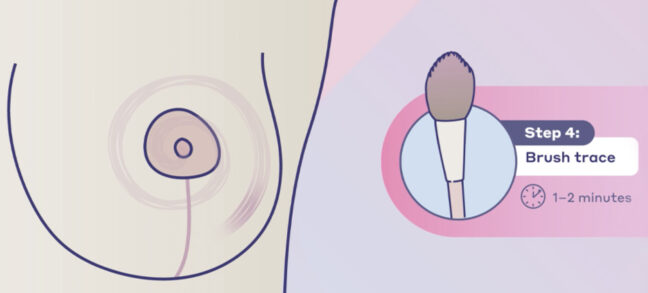When it comes to breast reconstruction, there is no one-size-fits-all answer. It’s important to look at the whole picture. For some, that means not only considering how breasts will look after reconstruction, but how they’ll feel—factoring in possible numbness after mastectomy. To help you understand loss of sensation and how advancements like Resensation® may fit into your breast reconstruction plan, we’re walking you through the basics.
what causes loss of sensation after mastectomy?
There are sensory nerves that run from your breast to your nervous system, sending signals that allow you to feel touch, temperature—even pain. But during mastectomy, these nerves need to be cut when the rest of the breast tissue is removed. If the nerves aren’t repaired during breast reconstruction, they can no longer send signals. No signals means no sensation. And often, even reconstructed breasts are permanently numb.
This can be true for standard mastectomies, as well as nipple-sparing mastectomies, in which the breast skin, nipple and areola are retained. The resulting numbness or loss of sensation has the potential to negatively impact a women’s quality of life, intimacy and body image.
In the past, reconstructive surgery mainly focused on restoring the size, shape, softness and symmetry of the breast. But what about sensation? Today, with the help of advancements like Resensation, that mentality is beginning to change. During Resensation a nerve allograft (donated human tissue) is used to reconnect and bridge the gap between the nerves in your chest and the nerves in your reconstructed breast tissue. The nerve graft guides regrowth of nerve fibers over time, potentially restoring sensation to the chest and breasts.
how might numbness impact you?
Women often say they weren’t prepared for how numb they would feel after mastectomy or just how much it would impact their daily lives3. Think of the awkwardness and discomfort you experience after leaving the dentist with numbed gums. Now imagine feeling that all the time, potentially for the rest of your life, and it covering a large portion of your chest.
It can be more than an inconvenience. It can be a safety issue, too. Without sensation, you’re unable to gauge whether water on your chest is too hot or if your seatbelt is too snug. You may not even be able to tell if your chest is injured while doing a physical activity. But perhaps worst of all, your sense of touch is gone. You may no longer be able to feel warm hugs from your loved ones, a head on your chest or simple pleasures like the soothing sensation of a soft sweater. You may also be surprised by how much numbness may impact intimacy in relationships.
when is resensation performed?
Resensation can be performed during an immediate reconstruction (at the same time as the mastectomy) or during a delayed reconstruction. The latter can take place months, or even years after the mastectomy. Women sometimes choose to revise a previous implant surgery. In some cases, it may be possible to include Resensation during your secondary reconstruction.
Timing is based on numerous factors, including your medical condition, cancer treatment and your desires. Take time to consider your needs and priorities, then sit down with your plastic surgeon to determine when is the right time for you.
finding the right plastic surgeon
Breast reconstruction is a very personal and often difficult journey, making your relationship with your plastic surgeon all the more important. You need someone you can trust and who makes you feel seen and heard as you express your concerns and desires.
Not all surgeons know about or can perform Resensation, but a growing number are offering it as an option. If you opt for breast neurotization with Resensation, you’ll need a plastic surgeon who has expertise in microsurgery and is skilled at using microscopes and precision instrumentation to repair blood vessels, nerves and other intricate structures.4
If you’re interested in pursuing Resensation, check out our surgeon locator tool to connect with a surgeon who can tell you more.
The level of sensation restored following use of the Resensation technique may vary and cannot be guaranteed, due to unique anatomy and other considerations. Please consult a surgeon for more detailed information.
References
- https://www.facs.org/media/press-releases/2017/mastectomy071717
- https://www.ncbi.nlm.nih.gov/pubmed/29721811
- Crohan S & Campbell A. Breast Sensations Research Report, Inspired Health, October, 2020. Report on file at Axogen.
- https://www.plasticsurgery.org/reconstructive-procedures/microsurgery
Resensation Articles

How does mastectomy impact the nerves in the breast?
One sometimes overlooked aspect of mastectomy is its impact on nerves. Read what happens to nerves during mastectomy and explore…
Read More
What happens during implant breast reconstruction with Resensation®?
By repairing sensory nerves, Resensation® enables you to potentially regain sensation to your chest. Read how this procedure works during…
Read More
how resensation® helped Leanna feel secure in her family’s future
With Resensation®, Leanna can be there to watch her kids grow up—without losing the feeling of being whole.
Read More
post-surgery sensory retraining: instructions and video guide
Sensory retraining is a series of exercises designed to help you reconnect with your body after breast reconstruction with Resensation®.
Read More